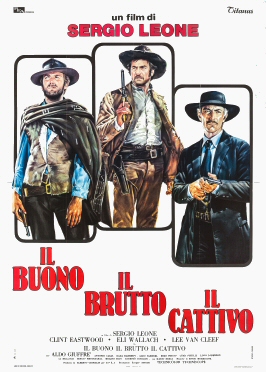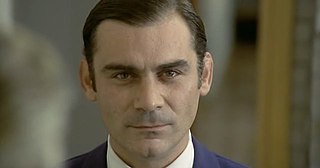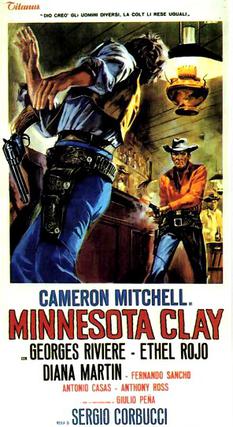
The spaghetti Western is a broad subgenre of Western films produced in Europe. It emerged in the mid-1960s in the wake of Sergio Leone's filmmaking style and international box-office success. The term was used by foreign critics because most of these Westerns were produced and directed by Italians.

The Good, the Bad and the Ugly is a 1966 Italian epic spaghetti Western film directed by Sergio Leone and starring Clint Eastwood as "the Good", Lee Van Cleef as "the Bad", and Eli Wallach as "the Ugly". Its screenplay was written by Age & Scarpelli, Luciano Vincenzoni, and Leone, based on a story by Vincenzoni and Leone. Director of photography Tonino Delli Colli was responsible for the film's sweeping widescreen cinematography, and Ennio Morricone composed the film's score, including its main theme. It was an Italian-led production with co-producers in Spain, West Germany, and the United States. Most of the filming took place in Spain.

Sergio Leone was an Italian film director, producer, and screenwriter, credited as the pioneer of the spaghetti Western genre. He is widely regarded as one of the most influential directors in the history of cinema.

A Fistful of Dollars is a 1964 spaghetti Western film directed by Sergio Leone and starring Clint Eastwood in his first leading role, alongside Gian Maria Volonté, Marianne Koch, Wolfgang Lukschy, Sieghardt Rupp, José Calvo, Antonio Prieto and Joseph Egger. The film, an international co-production between Italy, West Germany and Spain, was filmed on a low budget, and Eastwood was paid $15,000 for his role.

For a Few Dollars More is a 1965 Spaghetti Western film directed by Sergio Leone. It stars Clint Eastwood and Lee Van Cleef as bounty hunters and Gian Maria Volonté as the primary villain. German actor Klaus Kinski plays a supporting role as a secondary villain. The film was an international co-production between Italy, West Germany, and Spain. The film was released in the United States in 1967, and is the second part of what is commonly known as the Dollars Trilogy.

The Man with No Name is the antihero character portrayed by Clint Eastwood in Sergio Leone's "Dollars Trilogy" of Italian Spaghetti Western films: A Fistful of Dollars (1964), For a Few Dollars More (1965), and The Good, the Bad and the Ugly (1966). He is recognizable by his poncho, brown hat, tan cowboy boots, fondness for cigarillos, and the fact that he rarely speaks.

Duck, You Sucker!, also known as A Fistful of Dynamite and Once Upon a Time ... the Revolution, is a 1971 epic Zapata Western film directed and co-written by Sergio Leone and starring Rod Steiger, James Coburn, and Romolo Valli.

The revisionist Western is a sub-genre of the Western film. Called a post-classical variation of the traditional Western, the revisionist subverts the myth and romance of the traditional by means of character development and realism to present a less simplistic view of life in the "Old West". While the traditional Western always embodies a clear boundary between good and evil, the revisionist Western does not.
Mario Brega was an Italian character actor. His heavy build meant that he regularly portrayed a thug in his films, particularly earlier in his career in westerns. Later in his career, however, he featured in numerous Italian comedy films. Brega stood at 6 feet 4 inches (1.93 m) and well over 250 pounds (110 kg) at his heaviest but after the 1960s slimmed down significantly.

The Dollars Trilogy, also known as the Man with No Name Trilogy, is an Italian film series consisting of three Spaghetti Western films directed by Sergio Leone. The films are titled A Fistful of Dollars (1964), For a Few Dollars More (1965) and The Good, the Bad and the Ugly (1966). Their English versions were distributed by United Artists, while the Italian ones were distributed by Unidis and PEA.

Gian Maria Volonté was an Italian actor and activist, remembered for his versatility as a performer, his outspoken left-wing leanings, and fiery temper on- and off-screen. He is perhaps most famous outside Italy for his roles in four Spaghetti Western films: Ramón Rojo in Sergio Leone's A Fistful of Dollars (1964), El Indio in Leone's For a Few Dollars More (1965), El Chuncho Munoz in Damiano Damiani's A Bullet for the General (1966) and Professor Brad Fletcher in Sergio Sollima's Face to Face (1967).

Minnesota Clay is a 1964 Spaghetti Western directed by Sergio Corbucci.

Benito Stefanelli was an Italian film actor, stuntman and weapons master who made over 60 appearances in film between 1955 and 1991.
Luciano Vincenzoni was an Italian screenwriter, known as the "script doctor". He wrote for some 65 films between 1954 and 2000.

Edda Dell'Orso is an Italian singer known for her collaboration with composer Ennio Morricone, for whom she provided wordless vocals to a large number of his film scores. A soprano with a three-octave range, Dell'Orso also provided vocals to scores of other Italian composers such as Bruno Nicolai, Piero Piccioni, Luis Bacalov and Roberto Pregadio. She was born in Genoa.

Roy Colt & Winchester Jack is a 1970 Italian Spaghetti Western film directed by Mario Bava.

Bullets Don't Argue is a 1964 Italian Spaghetti Western directed by Mario Caiano. The film was produced by Jolly Film, back to back with Sergio Leone's A Fistful of Dollars, but with a more extensive budget and anticipating greater success than Leone's film, especially since at the time leading actor Rod Cameron was better known than Clint Eastwood.
Produzioni Europee Associati (PEA) is an Italian film production company founded in 1962 by Alberto Grimaldi to produce international co-productions. It released its first feature film The Shadow of Zorro in December that year. Its next production was its first Spaghetti Western: Texas Ranger released in 1964.

Savage Gringo is a 1966 Western film starring Ken Clark. The film is about a drifter who protects a rancher couple from a ruthless landowner. Under its Italian title, Savage Gringo was one of numerous Spaghetti Westerns retitled to take advantage of the success of Duccio Tessari's successful Ringo duology.















